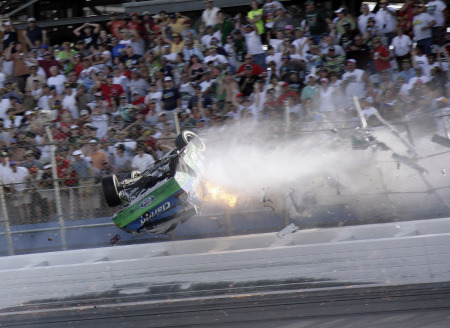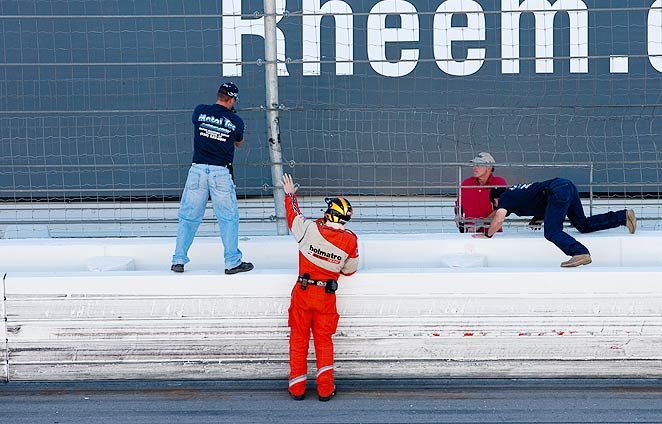Open cockpit biggest safety issue for open wheel
 |
 |
| IndyCar incorrectly thinks that putting bodywork behind the rear wheels of the new car (above) will prevent tire-to-tire contact and cars flying through the air. In the top photo from 2009 Carl Edwards flies through the air at Talladega in a stock car and their wheels are fully enclosed. BTW – he hit the catch fence hard. |
A reader writes, Dear AR1.com, When you first proposed IndyCar add a canopy to their cars to protect the driver's head I was against it. After reading this article I think there is no doubt they have to, especially since the driver's head is more exposed in the new car than the old car. This is another tragedy waiting to happen. Mary Dugan
"Obviously a lot of the serious injuries in IndyCar come from head injuries. Being covered like that, there is definitely a level of comfort. I’m pleased to have a roof over my head this weekend." — Danica Patrick in Texas this weekend for NASCAR race
11/03/11 The tragic loss of two-time Indianapolis 500 winner, Dan Wheldon, is without a doubt the most significant death in open-wheeled motor racing in nearly two decades.
Not since the loss of Ayrton Senna has an open-cockpit formula lost such a high profile driver, nor has there been such calling for re-evaluation of driver safety.
Both drivers suffered remarkably similar deaths with Wheldon's from blunt trauma to the head, and Senna's from multiple skull fractures. In the aftermath of Senna's accident, wide spread safety changes were made to improve the protection of the driver's head in Formula One.
Initially, the FIA increased crash safety standards, as well as the height of the sills around the cockpit to offer more protection (but IndyCar has lowered theirs with the new 2012 car). Additionally, in 1995, research began into the feasibility of using HANS (Head And Neck Support) after an accident caused Mika Hakkinen to suffer a fracture around the base of his skull. HANS is designed to stop the head from whipping forward, helping to prevent the occurrence of basilar skull fractures. It has been mandatory equipment for all drivers since 2003.
Even with such improvements, critics of motor racing most often credit speed as the main reason for driver fatalities and injury. In recent years, high-speed crashes in Formula One have resulted not in driver fatalities, but in drivers walking away unscathed. Robert Kubica's crash into a barrier at 186 mph in Canada in 2007, Mark Webber flipping end-over-end at 190 mph in Valencia in 2010, and Sebastien Buemi's front wheel sheering off at 190mph in China in 2010, have proven the strength and rigidity of the modern Formula One car. These select examples show that speed alone does not, in fact, kill.
 |
 |
| Note the bent Las Vegas Motor Speedway catch fence pole in the center of the photo. It is believed that this is the pole Wheldon's head hit that killed him. He hit so hard it bent the steel pole. |
The real danger in open-cockpit racing is more correlated to head trauma than to anything else. The death of Formula Two driver Henry Surtees, from a blow to the head from a detached wheel at Brands Hatch in 2009, as well as the loose suspension spring which struck Felipe Massa on the head in Hungary in 2009 and left him in a coma and out of racing for almost a year, are two prime examples. Both incidents show that a driver's exposed head is the weak point in driver safety for open-cockpit racing, meaning that the most important part of a driver is the most unprotected and exposed.
Wheldon's death has once again brought the subject of larger windshields and full canopy's to the for-front once again. The FIA conducted tests earlier this year to demonstrate the increase in head protection which would be obtained from implementing either. The idea was quickly dismissed by most in top-flight, feeling a covered cockpit would detract from racing and make removing drivers from crashes more difficult.
However, excitement and driver safety should not be mutually exclusive. Motor racing will always have some level of danger, but actions should be taken to prevent foreseeable avoidable incidents. A closed cockpit at the 2010 Abu Dhabi Grand Prix, for example, would have offered Michael Schumacher some form of protection when Vitantonio Liuzzi drove over his car, only missing his head by a few inches.
The inherent problem of motor racing is the strong resistance to any form of change. Safety has always been reactive instead of proactive. Wheldon's death should act as a wake up call, a watershed moment, for open-cockpit racing that the status quo is not enough to protect the lives of drivers. Formula One, as the world's top flight open-cockpit racing series, should lead by example and make aggressive changes to improve driver safety through increasing head protection. Motorsports runs the risk of becoming antiquated if they refuse to make concessions which would knowingly save lives.
Steve McQueen's excuse that auto racing is 'a professional blood sport' can no longer be used. In 1971 it may very well have been, but 40 years later it is the responsibility of those who love motor racing to ensure that anything and everything is being done to protect the lives of drivers.
Dan Wheldon's two sons shouldn't have to live with the reality that their father died because he chose a profession in which his life wasn't the number one priority. by J. Graham McCormick/Crash.net
 |
| Existing Dallara – Note exposure of drivers head |
 |
| New Dallara – note exposure of driver's head – worse than existing car – a tragedy waiting to happen |
 |
| Adrian Newey designed concept car with canopy – Now that is the car IndyCar should have built – it's safer and the fans would have loved it. Wow! |
 |
| McLaren F1 car fitted with a canopy |
|
FIA test showing how a canopy can protect an open wheel driver. Watch it all |
